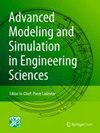基于非线性LATIN-PGD的工业数字孪生
IF 3.2
Q3 MECHANICS
Advanced Modeling and Simulation in Engineering Sciences
Pub Date : 2021-10-04
DOI:10.1186/s40323-021-00207-3
引用次数: 1
摘要
数字孪生(Digital Twins)往往会介入产品的整个生命周期,从早期设计阶段到预测性维护,再到优化过程,它正日益成为未来工业的重要组成部分。为了减少计算时间,降阶建模(ROM)方法是有用的。然而,由于相关算法具有很强的侵入性,因此很难将ROM方法引入商业有限元软件,这阻碍了ROM方法在工业层面的推广,从而阻止了在认证产品中集成强大可靠的工具。这项工作试图通过引入拉丁- pgd方法的弱侵入性重新制定来规避这个问题,该方法旨在直接嵌入Simcenter Samcef $$^{\hbox {TM}}$$有限元软件中。这种方法的独创性在于其非常通用的处理方式,允许PGD方法不仅处理特定的应用程序,而且处理此类软件中已经包含的所有功能-任何非线性,任何元素类型,任何边界条件……从而提供了一种新的高性能全包非线性求解器。本文章由计算机程序翻译,如有差异,请以英文原文为准。
Industrial Digital Twins based on the non-linear LATIN-PGD
Digital Twins, which tend to intervene over the entire life cycle of products from early design phase to predictive maintenance through optimization processes, are increasingly emerging as an essential component in the future of industries. To reduce the computational time reduced-order modeling (ROM) methods can be useful. However, the spread of ROM methods at an industrial level is currently hampered by the difficulty of introducing them into commercial finite element software, due to the strong intrusiveness of the associated algorithms, preventing from getting robust and reliable tools all integrated in a certified product. This work tries to circumvent this issue by introducing a weakly-invasive reformulation of the LATIN-PGD method which is intended to be directly embedded into Simcenter Samcef $$^{\hbox {TM}}$$ finite element software. The originality of this approach lies in the remarkably general way of doing, allowing PGD method to deal with not only a particular application but with all facilities already included in such softwares—any non-linearities, any element types, any boundary conditions...—and thus providing a new high-performance all-inclusive non-linear solver.
求助全文
通过发布文献求助,成功后即可免费获取论文全文。
去求助
来源期刊

Advanced Modeling and Simulation in Engineering Sciences
Engineering-Engineering (miscellaneous)
CiteScore
6.80
自引率
0.00%
发文量
22
审稿时长
30 weeks
期刊介绍:
The research topics addressed by Advanced Modeling and Simulation in Engineering Sciences (AMSES) cover the vast domain of the advanced modeling and simulation of materials, processes and structures governed by the laws of mechanics. The emphasis is on advanced and innovative modeling approaches and numerical strategies. The main objective is to describe the actual physics of large mechanical systems with complicated geometries as accurately as possible using complex, highly nonlinear and coupled multiphysics and multiscale models, and then to carry out simulations with these complex models as rapidly as possible. In other words, this research revolves around efficient numerical modeling along with model verification and validation. Therefore, the corresponding papers deal with advanced modeling and simulation, efficient optimization, inverse analysis, data-driven computation and simulation-based control. These challenging issues require multidisciplinary efforts – particularly in modeling, numerical analysis and computer science – which are treated in this journal.
 求助内容:
求助内容: 应助结果提醒方式:
应助结果提醒方式:


